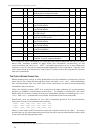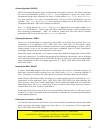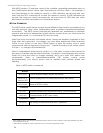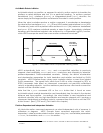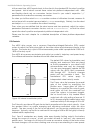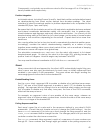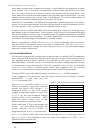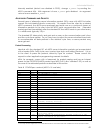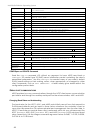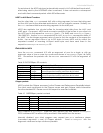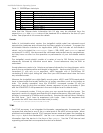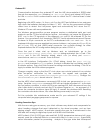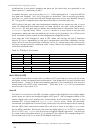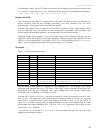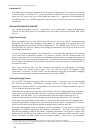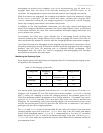
ActivMedia Robotics Operating System
received a command from a client. Restarts on restoration
of connection.
P2MPACS
byte 1 enables alternative SIP.
STALLVAL
int Maximum PWM before stall. If > PwmMax, never.
STALLCOUNT
int Ms time after a stall for recovery. Motors not engaged
during this time.
JOYVEL
int Joystick translation velocity setting, mm/sec
JOYRVEL
int Joystick rotation velocity setting in deg/sec
ROTVELMAX
int Current max rotational speed; deg/sec.
TRANSVELMAX
int Current max translational speed; mm/sec.
ROTACC
int Current rotational acceleration; deg/sec
2
ROTDECEL
int Current rotational deceleration; deg/sec
2
ROTKP
int Current Proportional PID for rotation
ROTKV
int Current Derivative PID for rotation
ROTKI
int Current Integral PID for rotation
TRANSACC
int Current translational acceleration; mm/sec
2
TRANSDECEL
int Current translational deceleration; mm/sec
2
TRANSKP
int Current Proportional PID for translation
TRANSKV
int Current Derivative PID for translation
TRANSKI
int Current Integral PID for translation
ADDED IN AROS 1.6
FRONTBUMPS
byte Number of front bumper segments
REARBUMPS
byte Number of rear bumper segments
ADDED IN AROS 1.7
CHARGER
byte 1 if P3 or 2 if PowerBot automated charger mechanism and
circuitry installed in robot; otherwise 0
ADDED IN AROS 1.8
SONARCYCLE
byte Sonar duty cycle time in milliseconds
AUTOBAUD
byte 1 if can change baud rates; 2 if auto-baud implemented
HASGYRO
byte 1 if has the gyro device; otherwise 0
CONFIGpac and CONFIG Command
Send the CONFIG command #18 without an argument to have AROS send back a
CONFIGpac SIP packet type 32 (0x20) server information packet containing the robot's
operational parameters. Use the CONFIGpac to examine many of your robot’s default
FLASH_based settings or their working values, when appropriate, as changed by other
client commands, such as SETV and ROTKV. A table nearby gives details about the
configuration packet data.
SERIAL PORT COMMUNICATIONS
AROS provides two-way communications through the HOST client-server communication
port and to and through two auxillary serial ports on the microcontroller, AUX1 and AUX2.
Changing Baud Rates and Autobauding
The baud rates for the HOST, AUX1, and AUX2 ports initially are set from their respective
FLASH-based defaults and get reset to those values whenever the controller is reset or
upon client disconnection. For advanced serial port management from the client side, in
AROS 1.8 and later we provide three client commands which let your software reset the
HOST (HOSTBAUD #50), AUX1 (AUX1BAUD #51), and AUX2 (AUX2BAUD #52) serial port baud
rates, respectively. Use the integer command argument values: 0=9600, 1=19.2K, 2=38.8K,
3=57.6K or 4=115.2K baud.
44



